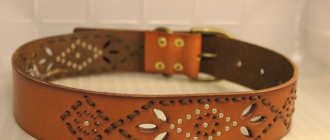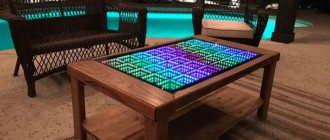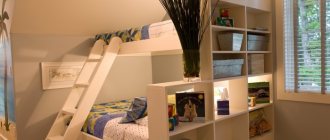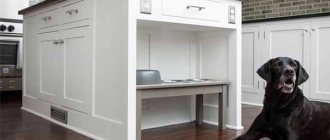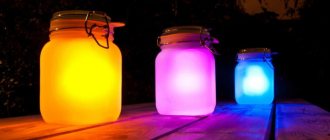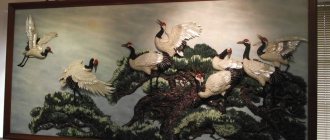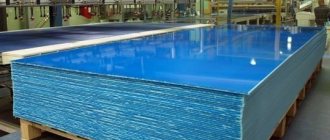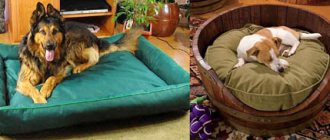Winter is approaching, the days are getting shorter, it's getting dark earlier, and if your dog is half as crazy as mine, you've probably lost track of him more than once when he's slipped out from under your nose on a walk.
Armed with a coin cell battery, a couple of LEDs, a clear flexible tube, a strip of leather, a button, some thread and a buckle, I'll show you how to make a glowing leather dog collar that will prevent your pet from sneaking out of your sight just as easily as before on a walk.
We will need:
- knife
- beeswax
- awl
- skin needles
- round punches
- mallet
- button installation kit
- cardboard for pattern
- durable, thin and flexible leather, preferably goatskin
- glue
- button
- waxed thread
- 5mm clear plastic tube
- two LEDs
- battery CR2032
►►Tools for leatherworking◄◄
We take measurements.
Measure your pet's neck and make a pattern out of cardboard. My neck is 33cm, which means the collar should be the same length along with the buckle. On the back of the buckle you need to make several additional holes so that you can adjust the size of the collar in case the dog grows or gets fat.
I started with the holes for the buckle - I punched an oval one in the middle of the belt and two round ones on the edges of it. On the pattern I marked several holes for the buckle tongue - 33cm, 35cm and 31cm.
I took the buckle 20mm wide, which means the tongue of the collar should be the same width so that it can fit freely into the buckle. On the pattern I marked the place for the battery and handset. I stepped back 3 mm from them to give a gap for their thickness for the seam.
Mark and cut out.
Lightly wet the leather and transfer the collar pattern onto it using an awl. You can also apply markings on the inner side of a piece of leather; here you can use a pen, since the ink will not be visible on the finished product.
Make sure the pattern is transferred evenly and cut out. This is not a race, take your time. Do not try to cut through the leather in one pass, it is better to do several, especially for thick leather.
Top seller
The most popular on the market today are LED dog collars from Ziver. The company offers a huge selection of sizes, each of which is available in three colors. For the convenience of the owner, there are three operating modes (flashing, glowing and off). The collar is waterproof, works great at any temperature and weather, the fastenings are made to last, the belt material is high-quality and durable. The neat shape of the box in which the battery is hidden is also attractive. It is not bulky and even elegant.
We fasten the buckle.
Now we will put our buckle and button in place. The button is needed to fix the battery and also to replace it. For the buckle we simply cut an oval hole. This can be done in several ways - punch two round ones and cut out the excess, or use an oval punch.
For the button, we punch two holes of suitable diameter and secure it with a set for installing buttons.
How to choose in a store
When buying ammunition for your pet, it is better to take it with you, since choosing a product in absentia is a complex process. Many stores allow you to try on accessories. A good harness should not dangle on the animal. If the accessory is not selected in size, then when moving it will move to the sides or slide down. The best alternative is to purchase a product with adjustable straps. It is not recommended to take tight models, so as not to make it difficult for the animal to breathe.
How to make the right choice
In conclusion, it should be said that all parts must be sewn firmly and efficiently so that the harness does not fail at the dog’s first serious tug. Before putting it on your dog, you need to determine the strength of the product. Belts can be made on rings to adjust their length.
*Prices are valid for January 2022*
We assemble the electronic part.
I don’t have a soldering iron and the last time I worked on radio electronics was more than 10 years ago, so forgive me for such a barbaric assembly method. But what we will do is not difficult and anyone can do it.
I found two pink LEDs, just right for a bitch. All I have to do is buy a battery - a CR2032 - of the right size to hide it in the collar. I did not include a resistor in the circuit, which only makes it easier for beginners.
I simply stuck LEDs on both sides of the tube and tied wires to their legs - not the best solution, but the entire structure can be removed from the collar and replaced. Perhaps in the future I will make a zippered pocket for a 9 volt battery.
At first I wanted to use one LED, but then I decided to connect two in parallel, so they would shine with approximately the same brightness.
Reflective Dog Collar
The simplest type is reflective. They are made of special reflective fabric, which allows you to see your pet in the dark only when light hits the collar. "Pros" of this type :
- works almost forever, does not require recharging or batteries;
- it is strong, so you can attach a leash to it;
- helps to protect your pet in urban conditions - drivers will notice it;
- does not irritate the pet with a constant glow;
- relatively low price.
There is only one “minus”, but it is quite significant: you can detect a dog in the dark only with the help of a backlight or a flashlight; this cannot be done in complete darkness. Thus, if you plan not to let your dog off the leash, then you can purchase this copy . Some similar models have built-in LEDs that eliminate this only drawback.
We glue.
Gluing is not necessary, but I find it easier to stitch if the two pieces don't move.
I applied leather glue around the perimeter of the collar, except where the battery will be placed and removed, on the buckle side. First I pressed one side of the collar, then I placed the tube with LEDs inside and pressed the other side.
With your own hands
If you have an LED strip at home (preferably with silicone protection), a collar and a special driver (to power the LEDs), then you can make this accessory yourself .
To do this, we sew or glue a luminous tape and a driver with inserted small batteries (AA) to the collar. It is best to place the driver in the place where the collar is fastened. There you go! It is important to avoid getting water on the device. But a waterproof pocket for the driver can easily handle this too.
A light-up collar can be very useful for your pet, so this accessory is worth purchasing. Choose it based on your goals. For example, if you need a durable one for use for 1-2 hours a day, then it is better to give preference to an LED one with USB charging. If you need it to work for a long time without electricity, then use batteries.
If you do not let your animal off the leash, but simply want drivers to notice your pet, then purchase a reflective one. The main thing is that not only you, but also, first of all, the animal likes it; it should feel comfortable in it.
Sew it together.
To sew, I take a thread about 3 collar lengths long and sew it with a saddle stitch.
Be sure to leave room to insert the battery inside the collar. To make sewing more convenient, I remove the battery and handset.
Once sewn, that’s it, the collar is ready, you can put the tube back and connect the battery.
I decided not to coat the collar with protective compounds or paint it. Over time, it will acquire a natural “tanned” color in the sun.
You can go for a walk!
Author of the master class emdiesse
Translation: LeatherThoughts
Luminous collars for dogs are undoubtedly convenient - in twilight and darkness the dog can be seen from afar, so the owner can be calm, seeing what the pet is doing, and knowing that drivers will notice him too.
The assortment of pardi.ru includes several luminous collars, these are the brands NiteIze, Easy Dog, Hunter, Trixie and Red Dingo. Let's look at each in more detail.
The first collars to appear in Russia were NiteIze NiteDawg - the fancy name “Night Dog” is easily understood as “night dog”. The collars are available in three sizes and two color variations - red and orange.
The collar consists of a battery pack with one diode and a thick light-conducting core, which is located in a nylon “case” with a fastex clasp, ring and length adjustment. Powered by a CR2032 coin battery, the battery pack is held together with four small screws (you will need a screwdriver to replace the batteries). It has 2 operating modes - constant light and flashing. The difference between the sizes is only in the length of the wire and the collar, so on sizes S and L the fasteners are the same, and the width of the collar is the same. By the way, to adjust the size, you will need to pull out the wires and cut them to the length you need, if the girth of your dog’s neck does not coincide with the maximum in this size.
Pros of the collar: This is, indeed, a collar - nylon, with a clasp and a ring, and new models have a reflective strip. Thus, the manufacturer suggests wearing it in the dark instead of the main collar, attaching an address tag and a leash to it. The filling is easy to remove, nylon is easy to wash and dries quickly, so the collar is not afraid of contamination.
Cons: The nylon tape dims the light, so the collar is not as bright as its non-nylon counterparts. In addition, at the maximum length, the light from the diode does not reach the very end. The collar adjustment is not tight, so it can move, expanding the girth of the collar so that the dog can wriggle out of it.
His mini brother - NiteIze NiteDawg XS - has a similar structure, with adjustments in size (it is designed for dogs with a neck circumference of 20-30cm): a smaller clasp, the collar itself is lighter and has a smaller width, the luminous wire is thinner. The battery pack is mounted on top of a nylon case. Available in two very bright neon colors - pink and yellow. Power: 2032 battery.
I recommend these collars to those who do not want to put a luminous collar on their dog in addition to the main one, but only for calm/well-mannered dogs, in order to avoid stretching the collar; for pulling dogs, you can hem it yourself, thus fixing the girth. All other collars are recommended as complementary only.
Another model from NiteIze - NiteHowl has a completely different structure. This is an open, luminous round conductor, both ends of which are inserted into a battery pack with 2 LEDs (the power button is on the outside). The collar is thinner than its older brother, brighter than it, because... It does not have a nylon coating, it looks more elegant, but it is absolutely not intended for holding a dog in any way. Recommended as a second collar, although a lightweight address collar can be hung by threading a wire through the address collar ring. The collar does not have a fastener and is simply worn over the head. Available in 3 colors (blue, green, red). The size is universal - the excess is simply cut off with scissors. Powered by 1154 batteries, the cover is secured with 1 screw. It also has 2 operating modes - continuous and flashing.
Red Dingo LUMITUBE has the same operating principle as NiteHowl , but has its own differences. Firstly, the luminous core has a smaller diameter, plus it is hollow inside, which makes the collar noticeably lighter, but in terms of brightness it is on par with NiteHowl . Plus, the battery pack has clamps that hold the core - to “unfasten” the collar, you need to press the locking button ( NiteHowl doesn’t have anything like that, the core is simply inserted into a hole in the block).
For power, LUMITUBE uses AAA “pinky” batteries, which are more common, but also more bulky. The battery pack does not have screws, the cover simply screws on - no screwdriver is needed, but you need to close it tightly and periodically check the tightness of the cover. The power button is located on the inside. Otherwise, everything is the same - two diodes, trimming the collar to the desired size. Colors red, blue, green and original purple.
Trixie
collars are available in two types - green and red, each comes in 3 sizes, but they all require cutting to the desired girth. 2 light modes - constant, slow flashing and fast flashing. And their most important difference from those described earlier is that they are charged via USB !
The green ones work according to the principle described above - a luminous core, but it is lit by only one LED (therefore, the part of the collar closest to it burns brighter), the core itself has a nylon cover and is attached to the detachable part of the battery pack with a small screw. The screw and tight clasp guarantee that the collar will not accidentally fall off the dog on the street, even during vigorous games.
Red collars are designed differently: adjacent to the battery block is a soft silicone tube, inside of which there are several LEDs, so the collar does not glow completely, but in a spot, but the diodes glow equally bright along the entire length. The battery block also has a connector, but the silicone is not fixed to it in any way, although if desired, it can be attached with glue.
Hunter
collars (colors orange, pink, lime, blue) and Easy Dog (colors red, orange, green, blue and the brightest white) also have a similar “spot” operation, and they also have USB charging. They don’t have any special differences between themselves, except that Hunter honestly put diodes along the entire length of the collar (70cm), but Easy Dog, although it fits on a neck with a girth of 75cm, does not have diodes for the last 20cm, so Easy Dog collars I recommend it for dogs with a neck circumference of no more than 55-60cm. But at the same time, as you can see in the photo, Easy Dog glows brighter. Both brands are also cut to size and have a “clasp” on the battery block.
If we compare them with Trixie, then it should be noted that the orange ones (Hunter and Easy Dog) have a distance between the diodes of about 5 cm, but the red Trixie has about 7.5. Thus, with the same length, Trixie will have one and a half times fewer diodes.
And this is what the filling of a collar with diodes looks like (I took apart my personal blue Easy Dog): two parallel wires, similar to a wire, with serial diodes. When shortening the collar, the wire is also cut off; you can cut it right after the last diode, without leaving any extra tails. And if the girth of the dog’s neck is small, then you can not cut off the extra diodes at all, but bend the wires and put the diodes in a tube in 2 rows.
And one more thing - the comparative sizes of NiteIze NiteDawg XS blocks and collars with USB charging: for NiteDawg the block, clasp and ring take up almost 9.5 cm - this part does not light up. The block of the USB collar is 2 cm shorter, but it does not bend, which would be inconvenient for a really small dog.
In general, I want to say that USB charging is undoubtedly convenient, because... eliminates the need to purchase the necessary batteries, but on the other hand, you need to charge such a collar on time.
Charging time is about an hour, operating time in continuous mode is about 3-4 hours, in flashing mode the operating time is longer.
Separately, it should be noted that all brands have a standard miniUSB port, so even if you lose the charging cable (which all come with), it won’t be difficult to find a replacement.
author: Alena Artamonova, especially for pardi.ru
How to sew an accessory yourself
Let's turn to how to make a dog harness with your own hands. After all, anyone can sew a harness. Professionals can go further and pamper their pet with an unusual accessory that they knitted with their own hands.
- Taking measurements of your pet.
Regardless of the chosen method of making your own harness, you have to start by taking measurements. Only correctly taken measurements will help you sew an accessory that is ideal for your pet.
The chest circumference is taken behind the dog's front legs at the widest point. To the resulting value you need to add 2 centimeters for a loose fit.
The girth of the neck is determined in the place where the animal usually wears a collar.
The length of the pet's back is measured from the withers to the base of the tail.
- Choice of material for the product.
The next step is choosing the material. Strength, wear resistance, softness and ease of cleaning - these are the requirements for harness fabric.
Cotton and linen are considered the most suitable - they breathe well, nylon is easy to clean and does not get wet, felt retains heat.
Don’t forget about rings, clasps, carabiners and Velcro, which will help the owner to easily remove and put on the harness on the pet.
- Constructing a pattern and sewing a product.
Having completed all the preparatory work, we proceed to constructing a pattern for the product. Don't forget about 2cm seam allowances on all sides. The resulting pattern will form the basis for cutting the product onto the fabric.
For the convenience of wearing the harness, we cut out 2 pieces of soft lining (1 piece is acceptable) separately from the base.
Of course, you can sew parts together with a needle and thread, but a product stitched on a sewing machine will look more neat.
Fold the lining in half and sew it along the entire perimeter. We sew the lining to the harness.
Our creation is almost ready. All that remains is to stitch the rings in the back area for ease of fastening the leash. It is recommended to sew parts using a zigzag stitch. It is this that allows you to firmly sew rings and fasteners, which take on the main load.
The straps can also be equipped with fasteners or Velcro to adjust their length if the pet is prone to obesity or is still growing. It’s good when the harness fits exactly to the dog’s body
But you should pay attention to ensure that it does not cause discomfort to the dog, does not tighten his chest, or digs into his body.
It can also be bad and uncomfortable for the animal when the belts of the product sag. This can also injure your pet or provoke a situation where he breaks free and is in danger, or when the straps dangle under his paws.
To make sure that the sewn product meets the safety requirements for wearing, you can use the following verification method: you just need to stick your palm between the harness and the dog’s body. If it passes freely, the product was successful. Don't despair when something doesn't go as planned. After all, everything can start over. No wonder popular wisdom says: “The first pancake is lumpy.” If the creative passion has left the needleworker, then the workshop will help make his dream come true.
A separate recommendation for those who chose leather as the material. As you know, this material has excellent stretchability. Then, if an error was made in the calculations and the product is too tight for your pet, then you can save the fruit of your labors and try to stretch the product. This can be done in several steps:
- place the product in water for 20-30 minutes;
- then remove from the water and, without getting wet, tightly wrap it around some cylindrical surface (but not the battery), for these purposes you can use a bucket or canister; if the surface is narrow, like a pipe, then the product will eventually be “curly” and will create inconvenience for the pet;
- When the leather is dry, it will need to be thoroughly lubricated with shoe polish or other thick industrial fat.
The only disadvantage of this method of saving the product is the likelihood that the belt will turn out to be too thin and may end up cutting too much into the skin of your furry friend.
Mr. Tail recommends: step-by-step instructions for making different harnesses
When it comes to purchasing a harness, the most important aspect is choosing the size. Some owners prefer to make the accessory themselves, taking into account the characteristics of the pet, its preferences, and purpose.
Measurements
First you need to take measurements, especially important: chest circumference at the widest point behind the front paws; base of the neck. They play a crucial role in planting ammunition. When taking measurements, there is no need to tighten the measuring tape; it is better to leave a margin of 2-3 cm for freedom of fit.
Before sewing, the harness model is determined based on the size and activity of the dog, the material and accessories (rings, carabiners) are selected.
Material selection
For small breeds (dachshunds, spitz, chihuahuas) - a harness-vest made of fabric is suitable. Velcro is acceptable as accessories; it is better not to use metal parts. Loops and connections are made from nylon inserts.
For large dogs (Alabai, Malamute, Husky) a riding harness is optimal; it is reliable, convenient for training with loads; for such dogs it is best to buy nylon or leather. Fasteners and connecting blocks are made of metal, the best fasteners are carabiners.
It is imperative to have a light walking harness at home, which will be most in demand and should be lightweight and durable; this type is most often made from synthetics. Materials corresponding to the size of the dog are used as fastenings.
Pattern
A large selection of harness cuts can be found on the Internet. The variety of types and sizes allows the owner to choose the option that is most convenient for the pet. Before starting work, it is recommended to adjust the pattern to the size of the animal; if this is not possible, choose a deliberately large model, then adjust the product by putting it on the animal.
Lining
Lining is used for riding harnesses, harnesses with weights and winter accessories. This can be any soft material that duplicates the product from the inside. Some people use old jeans or other simple, inexpensive fabrics. In order to reduce pressure and soften the harness, a thin foam insert is inserted between the main layers. On the back and chest, the belts are made wider to properly distribute the load.
Assembly instructions
Step by step:
- Print out the pattern and adjust to the size of the dog.
- Purchase the necessary materials and accessories based on the plan.
- Cut out the main parts and duplicate lining parts, if necessary. Be sure to leave allowances of 1-2 cm.
- Sew the parts on a machine using a zigzag stitch, which provides an additional margin of strength by stretching when jerking.
- Try the harness on the animal, adjust the necessary parts to fit the size.
- Form loops for inserting carabiners, rings or alternative types of fastenings. Sew them on a machine, drawing the shape of an envelope with a stitch. This fastening is strong and secures the fabric in the center and on the sides.
- Insert accessories.
- Carry out the final fitting by hooking the leash carabiner.
Regardless of the type and shape of the harness, the assembly instructions remain identical. Slight variations are possible when sewing products with lining and foam softeners.
